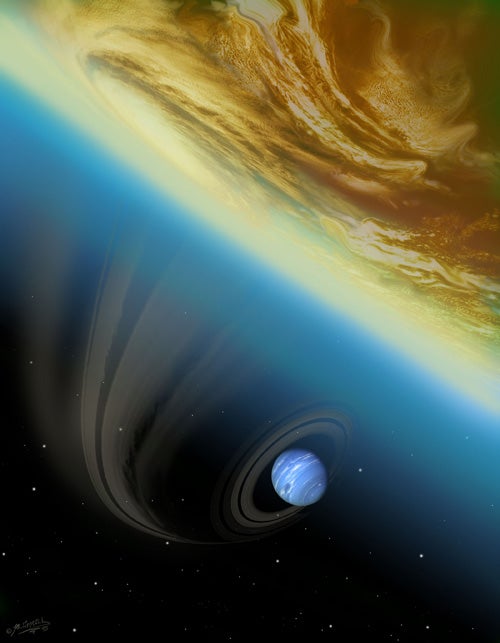Our solar system appears stable and well-ordered, with small planets near the Sun and larger planets farther away. But if computer models are right, this appearance is an illusion; our past was violent and chaotic. So says a new study by Hal Levison and colleagues, published May 26 in Nature. If the team’s hunch is correct, its theory would explain some long-standing mysteries of solar system history.
As coauthor Edward Thommes explains, the cores of the giant planets are ice-rich. All four began as icy bodies about the size of modern Neptune. Thommes and his team suggest Uranus and Neptune formed between Jupiter and Saturn during the first 10 million years of the Sun’s life, when the planets’ orbits were closer together.
Jupiter gained the most material from the solar nebula, swelling to 30 times its initial size. This triggered a great migration. As Jupiter’s orbit moved closer to the Sun, Saturn, Uranus, and Neptune slowly spiraled outward. Thommes tells Astronomy, “Jupiter reaches a threshold, and its increased mass destabilizes the other giants. The neighbors get gravitationally scattered.”
Some 700 million years after the solar system’s birth, Jupiter and Saturn began a cosmic cotillion that continues today. They became locked in orbital step, with Saturn orbiting the Sun exactly twice as long as Jupiter does. The gravitational forces of the two planets combined to alter the orbits of Uranus and Neptune. Their orbits became elongated, at times even crossing each other’s path. The two planets ventured so far out that they plowed through a vast band of ice and dust orbiting just outside the planetary quartet. Uranus and Neptune sailed through the icy band, casting debris into the inner solar system.
This violent game of cosmic billiards may explain what is known as the late heavy bombardment. About 3.8 billion years ago, the Moon and inner planets were pummeled by a heavy rain of asteroids, meteoroids, and comets. Most of the impact basins we see today were created in this cataclysm. The authors suggest the wayward orbits of the ice giants ushered in this epoch.
The new study proposes a revolutionary approach to planetary formation. Thommes comments, “It’s different from what people looked at before. Our main motivation was that Uranus and Neptune are so far away, with such long orbits, and with less material out there [in their formative epoch] that they couldn’t have formed where they are today in the time scales given. From observations of other stars, most of the solar nebula is gone within the first ten million years.” The new computer scenario answers these problems, says Thommes.










